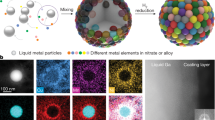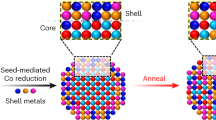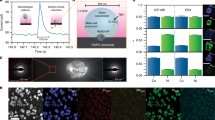Abstract
High-entropy materials, which include high-entropy alloys and high-entropy ceramics, show promise for their use in many fields, yet a robust synthesis strategy is lacking. Here we present a simple and general approach, laser scanning ablation, to synthesize a library of high-entropy alloy and ceramic nanoparticles. The laser scanning ablation method takes only five nanoseconds per pulse to ablate the corresponding nanoparticle precursors at atmospheric temperature and pressure. The ultrarapid process ensures that dissimilar metallic elements combine regardless of their thermodynamic solubility. As a laser pulse confines energy to the desired microregions, the laser scanning ablation method renders a high-entropy material nanoparticle loading on various substrates, which include thermally sensitive substrates. Applied as electrocatalysts for overall water splitting, the as-prepared high-entropy material nanoparticles can achieve an overpotential of 185 mV @ 10 mA cm–2. This versatile strategy enables the preparation of materials useful for a range of fields, such as biomedicine, catalysis, energy storage and sensors.
This is a preview of subscription content, access via your institution
Access options
Subscribe to this journal
Receive 12 digital issues and online access to articles
$119.00 per year
only $9.92 per issue
Buy this article
- Purchase on Springer Link
- Instant access to full article PDF
Prices may be subject to local taxes which are calculated during checkout





Similar content being viewed by others
Data availability
All the supporting data are provided in the main text and Supplementary Information. Source data are provided with this paper.
References
Ding, Q. Q. et al. Tuning element distribution, structure and properties by composition in high-entropy alloys. Nature 574, 223–227 (2019).
Oses, C., Toher, C. & Curtarolo, S. High-entropy ceramics. Nat. Rev. Mater. 5, 295–309 (2020).
Li, Z. M., Pradeep, K. G., Deng, Y., Raabe, D. & Tasan, C. C. Metastable high-entropy dual-phase alloys overcome the strength–ductility trade-off. Nature 534, 227–230 (2016).
Berardan, D., Franger, S., Dragoe, D., Meena, A. K. & Dragoe, N. Colossal dielectric constant in high entropy oxides. Phys. Status Solidi RLL 10, 328–333 (2016).
Sarkar, A. et al. High entropy oxides for reversible energy storage. Nat. Commun. 9, 3400 (2018).
Yao, Y. G. et al. Carbothermal shock synthesis of high-entropy-alloy nanoparticles. Science 359, 1489–1494 (2018).
Gao, S. J. et al. Synthesis of high-entropy alloy nanoparticles on supports by the fast moving bed pyrolysis. Nat. Commun. 11, 2016 (2020).
Liu, M. M. et al. Entropy-maximized synthesis of multimetallic nanoparticle catalysts via a ultrasonication-assisted wet chemistry method under ambient conditions. Adv. Mater. Interfaces 6, 1900015 (2019).
Waag, F. et al. Kinetically-controlled laser-synthesis of colloidal high-entropy alloy nanoparticles. RSC Adv. 9, 18547–18558 (2019).
Glasscott, M. W. et al. Electrosynthesis of high-entropy metallic glass nanoparticles for designer, multi-functional electrocatalysis. Nat. Commun. 10, 2650 (2019).
Rost, C. M. et al. Entropy-stabilized oxides. Nat. Commun. 6, 8485 (2015).
Yeh, J. W. Alloy design strategies and future trends in high-entropy alloys. JOM 65, 1759–1771 (2013).
Palneedi, H. et al. Laser irradiation of metal oxide films and nanostructures: applications and advances. Adv. Mater. 30, 1705148 (2018).
Xiao, J., Liu, P., Wang, C. X. & Yang, G. W. External field-assisted laser ablation in liquid: an efficient strategy for nanocrystal synthesis and nanostructure assembly. Prog. Mater. Sci. 87, 140–220 (2017).
Jeon, J. W. et al. The effect of laser pulse widths on laser-Ag nanoparticle interaction: femto- to nanosecond lasers. Appl. Sci. 8, 112 (2018).
Hashimoto, S., Werner, D. & Uwada, T. Studies on the interaction of pulsed lasers with plasmonic gold nanoparticles toward light manipulation, heat management, and nanofabrication. J. Photochem. Photobiol. C 13, 28–54 (2012).
Bewley, W. W. et al. Broad-stripe midinfrared photonic-crystal distributed-feedback lasers with laser-ablation confinement. Appl. Phys. Lett. 83, 5383–5385 (2003).
Miller, J. E., McDaniel, A. H. & Allendorf, M. D. Considerations in the design of materials for solar-driven fuel production using metal-oxide thermochemical cycles. Adv. Energy Mater. 4, 1300469 (2014).
Ruffino, F. & Grimaldi, M. G. Nanostructuration of thin metal films by pulsed laser irradiations: a review. Nanomaterials 9, 1133 (2019).
Bennett, T. D., Krajnovich, D. J., Grigoropoulos, C. P., Baumgart, P. & Tam, A. C. Marangoni mechanism in pulsed laser texturing of magnetic disk substrates. J. Heat Transfer 119, 589–596 (1997).
Semak, V. V., Knorovsky, G. A., MacCallum, D. O. & Roach, R. A. Effect of surface tension on melt pool dynamics during laser pulse interaction. J. Phys. D 39, 590–595 (2006).
Vales-Pinzon, C. et al. Increasing the thermal conductivity of silicone based fluids using carbon nanofibers. J. Appl. Phys. 120, 205109 (2016).
Yue, Y. A., Huang, X. P. & Wang, X. W. Thermal transport in multiwall carbon nanotube buckypapers. Phys. Lett. A 374, 4144–4151 (2010).
Han, M., Xie, Y. S., Liu, J., Zhang, J. C. & Wang, X. W. Significantly reduced c-axis thermal diffusivity of graphene-based papers. Nanotechnology 29, 265702 (2018).
Wood, R. F., Leboeuf, J. N., Chen, K. R., Geohegan, D. B. & Puretzky, A. A. Dynamics of plume propagation, splitting, and nanoparticle formation during pulsed-laser ablation. Appl. Surf. Sci. 127, 151–158 (1998).
Fang, J. X., Ding, B. J. & Gleiter, H. Mesocrystals: syntheses in metals and applications. Chem. Soc. Rev. 40, 5347–5360 (2011).
Luo, R. C., Li, C., Du, X. W. & Yang, J. Direct conversion of bulk metals to size-tailored, monodisperse spherical non-coinage-metal nanocrystals. Angew. Chem. Int. Ed. 54, 4787–4791 (2015).
He, Q. F. & Yang, Y. On lattice distortion in high entropy alloys. Front. Mater. 5, 42 (2018).
Tsai, C. W. et al. Strong amorphization of high-entropy AlBCrSiTi nitride film. Thin Solid Films 520, 2613–2618 (2012).
Mao, J. J. et al. Design of ultrathin Pt–Mo–Ni nanowire catalysts for ethanol electrooxidation. Sci. Adv. 3, 1603068 (2017).
Shi, X. Y. et al. Directed assembly of ultrasmall nitrogen coordinated Ir nanoparticles for enhanced electrocatalysis. Electrochim. Acta 370, 137710 (2021).
Lv, Z. Y. et al. Development of a novel high-entropy alloy with eminent efficiency of degrading azo dye solutions. Sci. Rep. 6, 34213 (2016).
Yu, X. et al. 2D high entropy hydrotalcites. Small 17, 2103412 (2021).
Li, X. Y., Rong, H. P., Zhang, J. T., Wang, D. S. & Li, Y. D. Modulating the local coordination environment of single-atom catalysts for enhanced catalytic performance. Nano Res. 13, 1842–1855 (2020).
Acknowledgements
This work was supported by the National Key Research and Development Program of China (2020YFA0710302), the Major Research Plan of the National Natural Science Foundation of China (91963206), the National Natural Science Foundation of China (52072169, 51627810 and 51972164), the Natural Science Foundation of Jiangsu Province (BK20201202), the Program for Guangdong Introducing Innovative and Entrepreneurial Teams (2019ZT08L101), the Open Fund of the Wuhan National Laboratory for Optoelectronics (2018WNLOKF020), the Postgraduate Research & Practice Innovation Program of Jiangsu Province (KYCX19_0043), the Fundamental Research Funds for the Central Universities (14380180) and the Civil Aerospace Technology Research Project (B0108).
Author information
Authors and Affiliations
Contributions
B.W., Y.Y., Z.L. and Z.Z. conceived the idea and designed the present work. B.W. carried out the experiments. C. Wang, X.Y. and C. Wu performed the detailed microscopic characterizations. Y.C. and L.G. directed the catalytic evaluation.
Corresponding authors
Ethics declarations
Competing interests
Provisional patent applications have been applied for through Nanjing University (China patent of 202011094113.4 and US patent of 20254CJH).The authors of Zhigang Zou, Bing Wang, Yingfang Yao, Congping Wu are invovled in the patent applications.
Additional information
Peer review information Nature Synthesis thanks Yadong Yin and the other, anonymous, reviewer(s) for their contribution to the peer review of this work. Peter Seavill was the primary editor on this article and managed its editorial process and peer review in collaboration with the rest of the editorial team.
Publisher’s note Springer Nature remains neutral with regard to jurisdictional claims in published maps and institutional affiliations.
Supplementary information
Supplementary Information
Supplementary Sections 1 and 2, Figs. 1–26 and Tables 1–4.
Supplementary Video 1
Expansion of bubbles into the hexane during laser ablation of carbon nanofibres with HAuCl4, FeCl3, CoCl2, CuCl2, CrCl3 salts.
Source data
Source Data Fig. 5
Electrocatalytic water-splitting performance.
Rights and permissions
About this article
Cite this article
Wang, B., Wang, C., Yu, X. et al. General synthesis of high-entropy alloy and ceramic nanoparticles in nanoseconds. Nat Synth 1, 138–146 (2022). https://doi.org/10.1038/s44160-021-00004-1
Received:
Accepted:
Published:
Issue Date:
DOI: https://doi.org/10.1038/s44160-021-00004-1
This article is cited by
-
Complete miscibility of immiscible elements at the nanometre scale
Nature Nanotechnology (2024)
-
Continuous synthesis of high-entropy alloy nanoparticles by in-flight alloying of elemental metals
Nature Communications (2024)
-
Challenging thermodynamics: combining immiscible elements in a single-phase nano-ceramic
Nature Communications (2024)
-
Laser-assisted synthesis of PtPd alloy for efficient ethanol oxidation
Nano Research (2024)
-
Corrosion Performance of Sn-Doped AlCrFeNiMn High-Entropy Alloy Synthesized via Arc-Melting Technique
Journal of Bio- and Tribo-Corrosion (2024)



